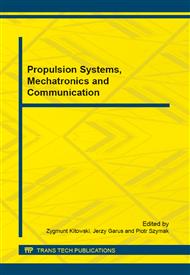p.3
p.13
p.19
p.27
p.34
p.41
p.47
p.57
Dry Friction Effect on the Work of Viscous Torsion Damper
Abstract:
The results of crankshaft forced vibration calculations, including the dry friction force which can be formed in the viscous damper bearing sliding, were presented. This problem concerns the big dampers used in the marine engines. The friction force influence is presented using the function {sign}. Low values of friction coefficient, corresponding to the conditions similar to the real ones, were assumed. In the range of tested value, it was found that the vibration increases linearly, and system free vibration frequency doesn’t change practically.
Info:
Periodical:
Pages:
13-18
Citation:
Online since:
January 2016
Authors:
Price:
Сopyright:
© 2016 Trans Tech Publications Ltd. All Rights Reserved
Share:
Citation:


